Assessing the costs of meeting Scotland's zero waste targets: report
Report examining the costs to local authorities of meeting the European Commission's Landfill Directive and Scottish Government Zero Waste targets.
Executive Summary
Purpose of the Report
1. One of the Scottish Government's strategic outcomes is that of creating a greener Scotland. As part of the drive towards this, Scotland faces the challenge of achieving ambitious targets for waste management. The Scottish Government recently reviewed the 2003 National Waste Plan for Scotland and subsequently produced "Scotland's Zero Waste Plan" and associated "Strategic Environmental Assessment" for consultation 1. Following the consultation, the government aims to introduce a new waste strategy for Scotland in 2010. This study will inform the new national waste strategy by answering two key questions:
- What new additional infrastructure will be required to meet Scotland's Zero Waste targets for municipal waste?
- What are the costs associated with achieving these targets?
Municipal Waste Targets
2. Scotland's waste management targets for Municipal Solid Waste ( MSW) fall into two main categories. The statutory waste management targets laid down in EU legislation and the more ambitious national targets set out by the Scottish Government.
EU Targets
3. Scotland must ensure that it meets its share of the statutory UK Landfill Directive targets (required under EC Landfill Directive 1999/31 2) and the EU's Waste Framework Directive (2008/98/ EC). In effect this means that collectively local authorities in Scotland must meet the following targets:
- by 2010 no more than 1.32 million tonnes of biodegradable municipal waste ( BMW) can go to landfill;
- by 2013 no more than 880,000 tonnes of BMW;
- by 2020 no more than 620,000 tonnes of BMW; and
- 50% reuse/recycling of household waste and similar by 2020.
Scottish Government Targets
4. In addition to the targets set out above, the Scottish Government has set a number of national waste targets as part of its policy of establishing Scotland as a "Zero Waste" nation. These targets focus on halting the growth of total MSW arising by 2010; increasing the levels of recycling and composting; setting a cap on Energy from Waste ( EfW) and reducing the amount of BMW going to landfill. The targets are summarised as follows:
- stop the growth of municipal waste by 2010;
- recycling/composting rates of at least 40% of municipal waste by 2010, rising to 50% by 2013, 60% by 2020 and 70% by 2025;
- by 2025 no more than 5% municipal waste to landfill (assumes all municipal, not just BMW); and
- 25% cap on the amount of waste used to produce energy.
Current Municipal Waste Management
5. Historically, Scotland's municipal waste programme has been dominated by landfill with 92% of municipal waste going to landfill in 2001/2002 3. Since then, significant progress has been made in reducing landfill, with corresponding growth in recycling and composting. By 2008/2009, Scotland had reduced its municipal waste going to landfill to 63% 4 and is on course to meet its 2010 obligations.
6. Although progress to date has been encouraging, the advances made so far will most likely prove to be the easiest steps on the road to a Zero Waste society as the more straightforward gains are achieved first. Consequently, future municipal waste management will prove more challenging and require further changes in our approach to waste management.
7. To achieve Scotland's municipal waste targets, costs will inevitably have to increase to help develop practices in waste management; invest in new technology; replace existing infrastructure; maintain or reduce waste arisings; embed recycling and composting practices through communication; and transform public values and behaviour towards waste generation and management.
Municipal Waste Future Scenarios
8. To ascertain what infrastructure is required to meet future waste obligations and how much it will cost, Scotland's future municipal waste streams were forecast. This study considered six scenarios that were modelled and these are summarised in Table 1.
Table 1 Waste Forecast Scenarios
Scenario Number |
Description |
|---|---|
Scenario 1a. Do Nothing (With Landfill Fines) |
Continue at 2008/2009 levels of municipal waste processing and at present cost levels. No change in waste streams. The appropriate landfill fines are imposed. |
Scenario 1b. Do Nothing (No Landfill Fines) |
Continue at 2008/2009 levels of municipal waste processing and at present cost levels. No change in waste streams. No landfill fines are imposed. |
Scenario 2. EUWFD Only |
Meet all EU statutory obligations (only) such as the Waste Framework Directive and the Landfill Directive (e.g. landfill targets for 2010, 2013 and 2020; and 50% recycling/composting by 2020), but not the Scottish Government targets. |
Scenario 3. EUWFD & SG Targets (50/20) |
Meet all EU statutory obligations and all Scottish Government targets. This scenario assumes a 50/20 split between source segregation and residual waste treatment to meet the 70% recycling and composting target. |
Scenario 4. EUWFD & SG targets (60/10) |
Meet all EU statutory obligations and all Scottish Government targets as per scenario 3 except this scenario assumes a 60/10 split between source segregation and residual waste treatment to meet the 70% recycling and composting target. |
Scenario 5. EUWFD & SG Targets (65/5) |
Meet all EU statutory obligations and all Scottish Government targets as per scenario 3 except this scenario assumes a 65/5 split between source segregation and residual waste treatment to meet the 70% recycling and composting target. |
Scenario 6. EfW cap by 2018 |
Meet all EU statutory obligations and all Scottish Government targets as in scenario 3 except that EfW reaches its 25% cap earlier in 2018. |
Source: SQW Energy [n.b. any increases in landfill tax after 2013 (as announced in the March 2010 budget) will impact on the costs presented, particularly 1a and 1b where more waste is landfilled]
9. Scenario 1a and 1b presents the 'Do Nothing' option as a datum to illustrate the implications of continuing in a 'business as usual' manner with no change in procedure or to the costs of dealing with municipal waste. Scenario 1a includes any landfill fines imposed for missing targets, while Scenario 1b does not take into account landfill fines. Scenario 2 highlights the minimum required to comply with EU statutory obligations only and avoid any penalties. Scenario 3, 4 and 5 demonstrate what is needed to meet all EU statutory obligations and achieve the targets set down by the Scottish Government with varying degrees of source segregation. Scenario 6 also meets EU and Scottish Government targets, but shows the effect of bringing EfW online sooner.
Municipal Waste Targets and Forecasts
10. Figure 1 illustrates the municipal waste arising forecast to 2025 that would meet the requirements set out by the EU and Scottish Government.
Figure 1 Municipal Solid Waste Arising (Meet all EU and Scottish Government Targets)
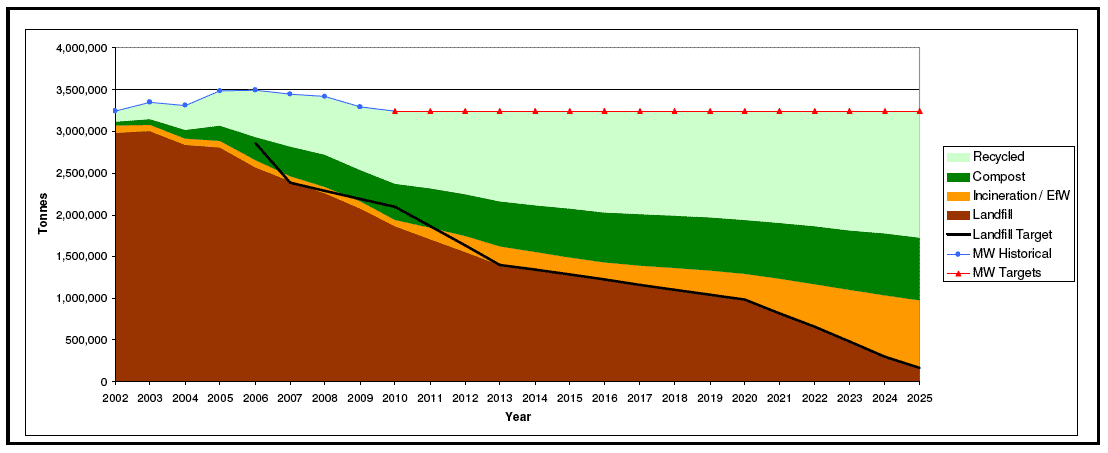
Source: SQW Energy
11. To meet all targets and obligations, each waste stream forecast to 2025 is effectively determined by the waste management targets set down by the EU and the Scottish Government. The EU landfill targets are the primary goal as they are legally binding and limit the absolute quantity of BMW sent to landfill. In conjunction with the EU Landfill Directive, the targets for recycling and composting must be achieved and these are expressed as a percentage of the total municipal waste arising. The goal of no growth beyond 2010 of the total municipal waste arising puts an upper limit on future forecasts. As a result, if EU landfill targets are not met, then it becomes more difficult to achieve the Scottish Government recycling and composting targets and vice versa.
12. This leaves the EfW waste stream. The maximum that can go to EfW is the waste that remains once the other targets are satisfied. In Scenario 3, EfW does not reach its cap until 2025. In effect, if the national targets are to be met exactly (no more, no less), the sizes of Scotland's municipal waste streams to 2025 are pre-defined by the targets.
Waste Management Infrastructure
13. From Figure 1 it can be seen that further change is required in the way municipal waste in Scotland is managed if national municipal waste targets are to be achieved. Existing infrastructure capacity will be insufficient to meet these targets.
14. For each of the scenarios, the type, capacity and timing of waste infrastructure required to meet future waste targets was calculated by:
- Identifying the existing waste infrastructure in each of the Waste Strategy Areas ( WSA) - see Annex C for WSA definitions;
- Estimating the shortfall between existing capacity and future annual requirements; and
- Calculating the additional infrastructure required to meet the forecasted demand in each year for each of the WSAs.
These estimates were then aggregated to give the national picture with the size and timing of new infrastructure units scheduled to 2025.
15. At a national level, the additional infrastructure required to meet all EU and National municipal waste management targets to 2025 (Scenario 3 with 50% source segregation), excluding existing infrastructure that is replaced, is shown in Table 2.
Table 2 Additional waste infrastructure required in Scotland to meet all targets (Scenario 3)
Waste infrastructure required |
No. of units |
Operational capacity |
Total Capacity |
|---|---|---|---|
aerobic (1,000t) |
0 |
1,000 |
0 |
aerobic (10,000t) |
2 |
10,000 |
20,000 |
aerobic (25,000t) |
2 |
25,000 |
50,000 |
aerobic (50,000t) |
3 |
50,000 |
150,000 |
anaerobic (1,000t) |
4 |
1,000 |
4,000 |
anaerobic (5,000t) |
5 |
5,000 |
25,000 |
anaerobic (30,000t) |
5 |
30,000 |
150,000 |
anaerobic (50,000t) |
2 |
50,000 |
100,000 |
EfW (8,000t) |
4 |
8,000 |
32,000 |
EfW (64,000t) |
6 |
64,000 |
384,000 |
EfW (200,000t) |
0 |
200,000 |
0 |
MBT (8,000t) |
4 |
8,000 |
32,000 |
MBT (40,000t) |
4 |
40,000 |
160,000 |
MBT (80,000t) |
9 |
80,000 |
720,000 |
* For modelling purposes EfW and MBT plants are assumed to operate at 80% of total stated capacity to reflect downtime for maintenance and repairs.
Source: SQW Energy
16. Figure 2 illustrates the capacity of additional infrastructure required and the year by which it must be operational to meet all EU and Scottish Government waste management targets set out in Scenario 3.
Figure 2 Infrastructure Capacity Requirement to meet EU & Scottish Government Targets (Scenario 3) with 50% source segregation.
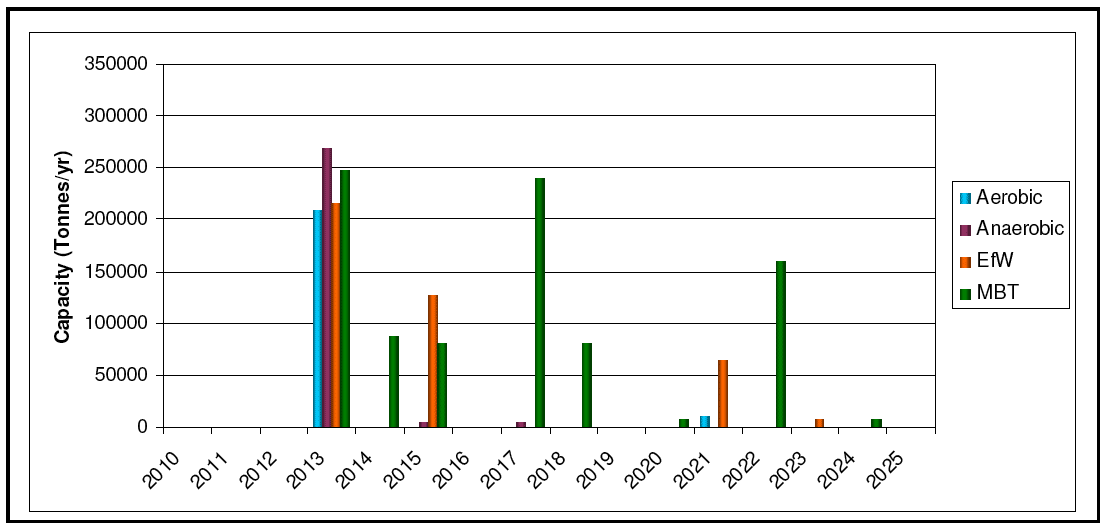
Source: SQW Energy
17. It can be seen that there is a significant requirement for additional infrastructure to be operational by the year 2013. Assuming a minimum two to three year lead time for most infrastructure projects, steps must be taken now if the 2013 targets are to be met.
18. Although all four technologies analysed require similar capacities to be operational by 2013, both EfW and MBT will require additional capacity to be commissioned between 2013 and 2025.
19. There is a growing requirement for MBT infrastructure, chiefly composed of medium and large units, as source segregation approaches its maximum capture rates (for Figure 2 (Scenario 3) -assumed to be 50% of Total Waste Arising) and as demand for EfW feedstock comes on stream.
20. Once the appropriate capacity of Aerobic and Anaerobic infrastructure is commissioned by 2013, there is little requirement for additional composting infrastructure.
21. Of the six scenarios examined, Scenario 5 was the most cost efficient scenario, primarily due to the increased levels of source segregation. Of the three 'meet all targets' scenarios (scenario 3 to 5), the Net Present Cost ( NPC) reduces as more source segregation is done. This is due to a combination of reduced infrastructure required to process residual waste and less processing costs as sorting and processing costs are shifted towards the point of waste collection.
22. Scenario 5 has source segregation levels of 65%. Figure 3 shows the capacity of additional infrastructure required and the year by which it must be operational to meet all EU and Scottish Government waste management targets set out in Scenario 5.
Figure 3 Infrastructure Capacity Requirement to meet EU & Scottish Government Targets (Scenario 5) with 65% source segregation.
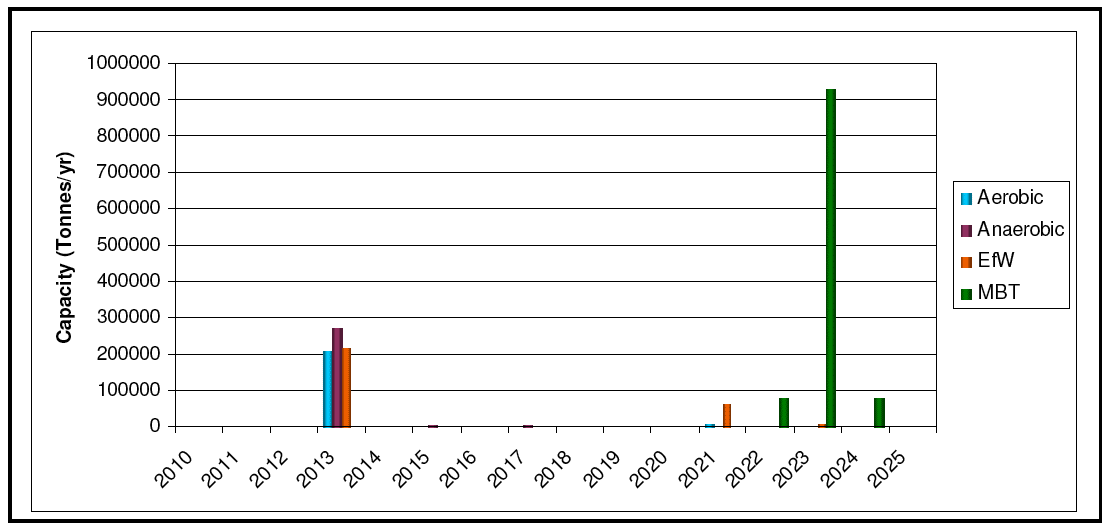
Source: SQW Energy
23. By increasing the level of source segregation (as in Scenarios 4 and 5), the requirement for infrastructure, particularly MBT, is delayed significantly. If the lead time to get new infrastructure installed by 2013 is insufficient (for example due to planning constraints), then increasing the level of source segregation offers an alternative solution.
24. In effect, by continuing to improve the capture rates of current collection infrastructure and increasing source segregation, processing costs are shifted towards the waste producer rather than centralised MBT units.
Cost Benefit Analysis
25. The annual net cost of collecting and processing all the municipal waste in Scotland according to the most recent publicly available data (2007/2008) is £404 million 5. For this study, Scotland's future waste management requirements were modelled to assess the financial impacts above and beyond existing spending levels under the six scenarios through to 2025.
26. Detailed costs and benefits of implementing the six waste management scenarios were evaluated in line with the HM Treasury Green Book 6. This included the capital cost of new infrastructure; the cost of collecting; processing; landfill fines and the benefits arising from processed waste (e.g. recyclate revenue, generated electricity, etc). The cost benefit analysis did not account for non-market benefits (externalities). The headline results of the Cost Benefit Analysis ( CBA) are shown in Table 3.
27. Table 3 shows, for each of the scenarios, a breakdown of the Net Present Value ( NPV) for each of the main elements associated with implementing municipal waste management in Scotland to 2025. The Net Present Cost to 2025, if current levels of spend (£404M) are continued, is £5,069 million. The final column shows the Net Present Cost, over and above current spending levels, of implementing each of the scenarios.
Table 3 - Cost Benefit Analysis (2010 to 2025) - all figures are Net Present Value
Scenario |
Collection |
Processing |
Landfill Fines |
Infrastr. Investment |
Benefits |
Total Net Present Cost |
Cost in excess of current NPV spend levels |
|---|---|---|---|---|---|---|---|
1a. Do Nothing (with Landfill Fines) |
£2,480 |
£4,115 |
£1,288 |
£91 |
£559 |
£7,415 |
£2,346 |
1b. Do Nothing (without Landfill Fines) |
£2,480 |
£4,115 |
0 |
£91 |
£559 |
£6,127 |
£1,058 |
2. EU Only |
£3,347 |
£3,431 |
0 |
£434 |
£697 |
£6,514 |
£1,445 |
3. EU & SG Targets (50/20) |
£3,763 |
£3,006 |
0 |
£449 |
£682 |
£6,536 |
£1,467 |
4. EU & SG Targets (60/10) |
£3,724 |
£2,888 |
0 |
£342 |
£682 |
£6,271 |
£1,203 |
5. EU & SG Targets (65/5) |
£3,695 |
£2,799 |
0 |
£303 |
£682 |
£6,114 |
£1,046 |
6. EfW Cap by 2018 |
£3,811 |
£2,981 |
0 |
£646 |
£741 |
£6,697 |
£1,628 |
Source: SQW Energy
28. The Collection and Processing costs of each scenario are shown for the period to 2025. Landfill Fines are shown separately to demonstrate the level of penalty enforced. The capital investment in new infrastructure required to achieve each of the scenarios is then given. The total market benefits of each scenario are then set out. (n.b. this does not include any non-market costs/benefits (externalities)).
29. The Net Present Cost figure represents the amount over and above the current level of spending ( NPV=£5,069M) that would be required through to 2025 to implement each of the scenarios. To meet all EU and Scottish Government waste management targets, Scenario 5 (with 65% source segregation) gave the most cost effective solution and required the following from 2010 to 2025:
- NPV Infrastructure Investment = £303 million
- Net Present Cost in excess of present spend levels = £1,046 million
30. Where source segregation levels are lower but all EU and Scottish Government targets are still achieved (as shown in Scenarios 3 and 4) the costs were significantly higher. In effect, by continuing to improve the capture rates of current collection infrastructure and increasing source segregation, costs can be shifted towards the waste producer rather than centralised MBT units.
31. To achieve EU statutory obligations (only) would cost £1,445 million above current spending. To also realise the Scottish Government's more ambitious targets (Scenario 3) would cost an extra £22 million over the same waste strategy timeframe with an extra £15 million ( NPV) of infrastructure investment assuming only 50% source segregation is achieved.
32. Scenario 1a (Do Nothing with Fines) is the most expensive option due to the landfill fines incurred for missing landfill targets. Scenario 1b (Do Nothing without Fines) is the second most cost efficient scenario, but is still slightly more expensive than the high source segregation Scenario 5. Therefore, even if landfill fines are not imposed, it would still make economic sense to strive for greater source segregation rather than continue with a business as usual policy.
33. Under Scenario 6, it is between £161 million and £582 million more expensive to bring EfW capacity online sooner than the other 'on-target' scenarios, predominantly due to the additional infrastructure investment required.
34. Figure 4 illustrates the costs/benefits associated with implementing each of the waste management scenarios.
Figure 4 - Cost Benefit Analysis Breakdown for Each Scenario
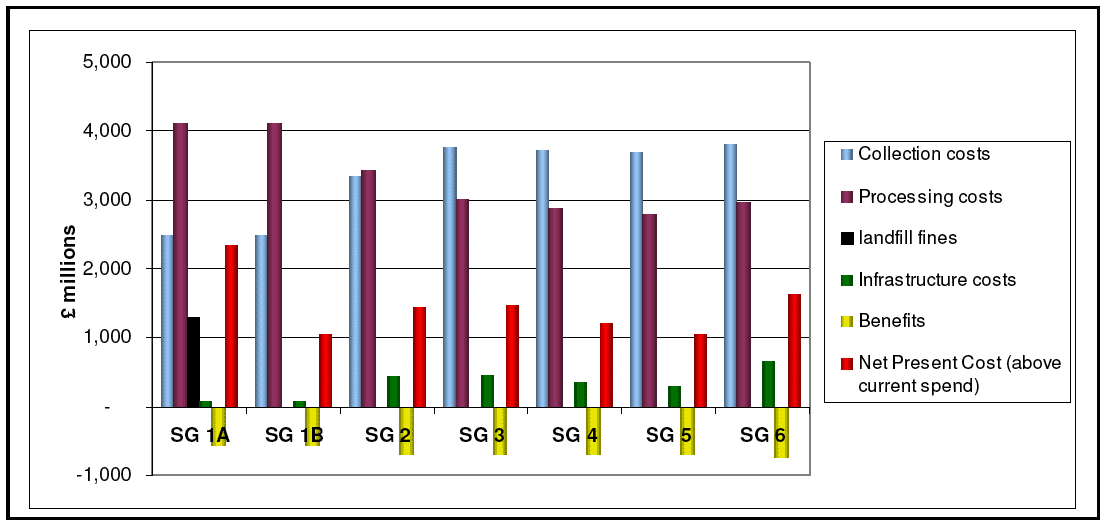
Source: SQW Energy
35. It can be seen that although infrastructure investment is significant, by far the most significant factors are collection and processing costs.
36. Even in the best case scenarios, the benefits from waste management are only capable of marginally off-setting the costs of waste management although this may not be the case if non-market benefits are quantified and included in the analysis.
37. Of the three 'meet all targets' scenarios (scenario 3 to 5), the Net Present Cost reduces as more source segregation is done. This is due to a combination of reduced infrastructure required to process residual waste and less processing costs. Processing costs are reduced by gaining efficiencies from current collection infrastructure and increasing source segregation; hence processing costs are shifted towards the waste producer rather than centralised MBT units.
38. Figure 5 shows the additional costs annually of each scenario, on a nominal basis. It illustrates that the timing of expenditure is very different between scenarios and is important in terms of overall cost efficiency. It can be seen that although Scenario 5 costs considerably more after 2022, the Net Present Cost of Scenario 5 has the lowest NPV because the major expenditure is delayed until later years. For this reason, Scenario 5 is more cost efficient than all other scenarios, including Scenario 1B (Do Nothing - without Landfill Fines).
Figure 5 - Additional Costs in Excess of Existing Expenditure (Nominal)
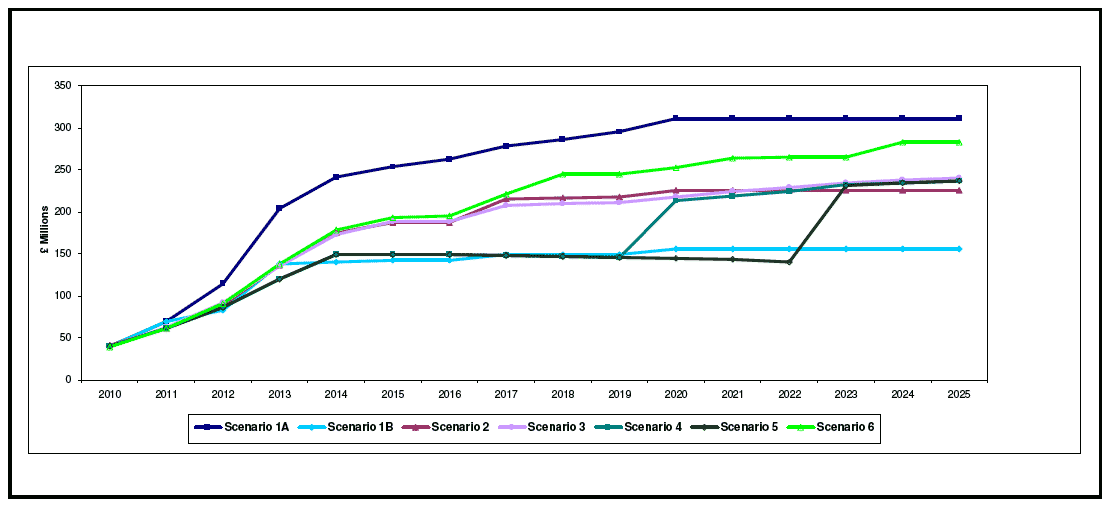
Source: SQW Energy
Conclusions
39. Regardless of what future waste scenario is considered, the cost of managing Scotland's waste will increase.
40. The option of 'doing nothing with landfill fines' is by far the most costly due to landfill penalties and the environmental impact.
41. It is more cost effective to meet the EU statutory obligations and avoid landfill fines. To meet EU obligations (only) would require an NPV investment of £434 million in new infrastructure and cost an additional £1,445 million above current spending levels over the waste strategy period (2010 - 2025).
42. To meet the more ambitious Scottish Government targets for waste management would require a modest increase in investment over that of EU compliance. For Scenario 3, this would mean an NPV investment of £449 million in new infrastructure and cost an additional £1,467 million above current spending levels over the waste strategy period (2010 - 2025).
43. If the EU and Scottish Government targets can be met with more source segregation and less residual processing, investment costs can be reduced through less need for MBTs as illustrated in Scenarios 4 and 5. The 60/10 and 65/5 split of Scenario 4 and 5 both delay the need for infrastructure, particularly MBT, and allow more time to plan for and establish infrastructure.
44. In terms of infrastructure, smaller units may be more affordable for smaller local authorities, but there are significant economies of scale to be attained by choosing larger plants. There are significant potential savings to be made by having co-operation and combined infrastructure solutions between local authorities.
45. Collection and processing drive the overall cost of waste management. To meet all targets in Scenario 3, the infrastructure costs are approximately £449 million NPV. However, this is dwarfed by the operational costs - collection (£3.8 billion NPV) and processing (£3.0 billion NPV). Therefore the largest savings are to be gained in reducing collection and processing costs through reducing waste arisings, increased source segregation and more efficient infrastructure use (e.g. higher participation, higher capture rates and lower contamination) and further work is recommended in these areas.
46. It is therefore recommended that further work is required to:
- Invest in effective communication and education including on the non-market benefits of investing in prevention, reuse and recycling;
- Better understand the efficiencies in collection infrastructure;
- Improve data collection on costs for collection, processing and infrastructure; and
- Better understand the synergies between MSW and other waste streams in terms of shared infrastructure.
Contact
Email: Central Enquiries Unit ceu@gov.scotEmail: Central Enquiries Unit ceu@gov.scot
There is a problem
Thanks for your feedback